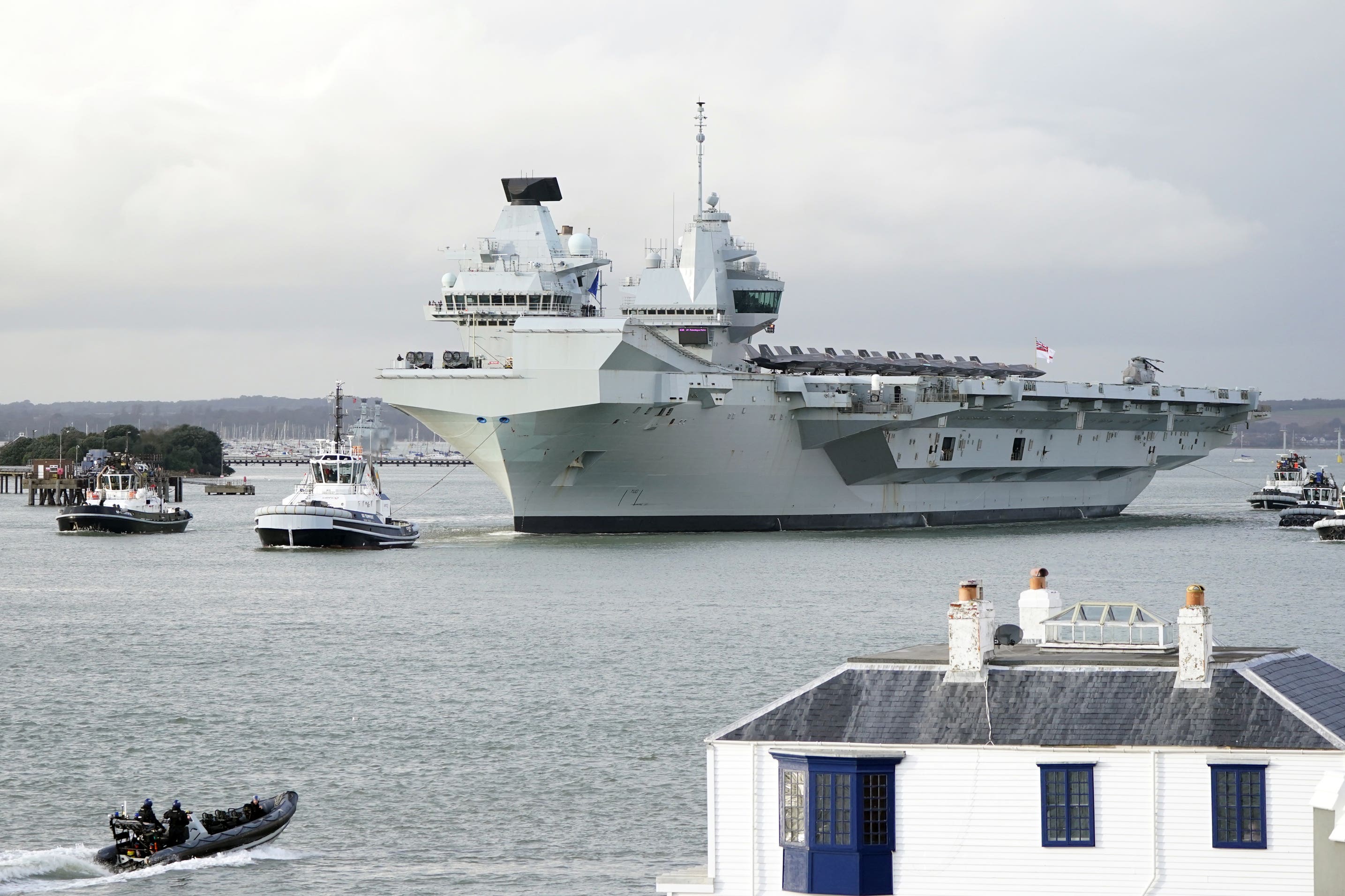Faulty Navy flagship pulls out of historic Nato drill as MPs warn UK’s ‘hollowed out army unfit for war’
The setback came as ministers were warned Britain is not sufficiently prepared to fight an all-out war due to stockpile shortages and an armed forces recruitment crisis
The departure of the Royal Navy aircraft carrier HMS Queen Elizabeth to lead the largest Nato exercise since the Cold War has been cancelled at the last minute after an “issue” with a propeller shaft was spotted during final checks.
The setback comes 18 months after sister ship HMS Prince of Wales broke down off the Isle of Wight after it sailed for the US having suffered a malfunction with a coupling on its starboard propeller.
It will now be readied to take the place of the £3bn fleet flagship on the major exercises which will involve more than 40 vessels.
The blow comes as ministers were warned Britain is not sufficiently prepared to fight an all-out war amid stockpile shortages and an armed forces recruitment crisis.
The House of Commons defence committee said the military is “consistently overstretched”, with the “unrelenting pressure” on personnel exacerbating the crisis in recruitment and retention which is seeing more people leaving the armed forces than joining.
The cross-party group of MPs said the UK’s military has been “hollowed out”, leaving Britain unprepared for war at a time of worsening global instability. Defence secretary Grant Shapps has said the world is “moving from post-war to pre-war”.

Announcing the latest problem, the Royal Navy posted on Twitter/X: “Routine pre-sailing checks yesterday identified an issue with a coupling on HMS Queen Elizabeth starboard propeller shaft. As such, the ship will not sail on Sunday.
“HMS Prince of Wales will take her place on Nato duties and will set sail for exercise Steadfast Defender as soon as possible.”
HMS Prince of Wales broke down as it was heading to a diplomatic mission to carry out exercises with the US Navy, Royal Canadian Navy and the US Marine Corps.
The carrier came to a halt off the Isle of Wight and was brought under tow back into harbour for the problem to be identified.
Inspections by divers and engineers found the Nato flagship’s 33-ton starboard propeller – the same weight as 30 Ford Fiesta cars – had malfunctioned, with a coupling holding it in place breaking.
It was then taken to the Babcock shipyard where it was built in Rosyth, Fife, to undergo repairs to a propeller shaft, which took nine months to complete.
On that occasion, HMS Queen Elizabeth acted as the replacement for its sister ship on the US deployment.
Having HMS Queen Elizabeth out of action could affect the ability of the Royal Navy to deploy an aircraft carrier to the Red Sea amid the continuing threat by Iran-backed Houthi rebels which armed forces minister James Heappey has suggested was being considered.
HMS Prince of Wales will now take over the lead of exercise Steadfast Defender, which will take place off Norway’s Arctic coast in March.
Its sister ship had been set to lead a carrier strike of eight ships – four of them British, including frigate HMS Somerset and two Tide-class tankers from the Royal Fleet Auxiliary – supported by US, Spanish and Danish vessels.
It was to be joined by its F-35B Lightning stealth fighters from 617 “Dambusters” Squadron at RAF Marham, submarine hunting and airborne early warning Merlin Mk2 helicopters from RNAS Culdrose, and battlefield Wildcat helicopters of 847 Naval Air Squadron from RNAS Yeovilton.
Announcing the carrier’s sailing, Commodore James Blackmore, Commander UK Carrier Strike Group, said: “Steadfast Defender demonstrates the unity of the alliance, our commitment to it – and that the UK continues to play a leading role in Nato.
“The exercise allows us to train with our neighbours in a truly challenging environment, especially at this time of year – but that is why we have to operate up there; the weather cannot put us off.”
Before heading to the Arctic, the Carrier Strike Group was due to take part in the annual Joint Warrior exercise off northern Scotland before joining exercise Nordic Response – the maritime part of Steadfast Defender.
The defence committee’s inquiry heard that the “hollowing out” of the armed forces since 2010 had undermined the UK’s warfighting resilience and that their reduction in size meant they would exhaust their capabilities “after the first couple of months of the engagement” in a peer-on-peer war.
Readiness “is essential to effective deterrence to our adversaries” at a time of heightened geopolitical instability, they said.

Sir Jeremy Quin, who recently took over as defence committee chair, said: “A steady, continuous drip of operations and ongoing commitments has meant the military is unable to devote sufficient training and resources to high-intensity warfighting.
“While able to deploy at short notice and to fulfil commitments, our inquiry found that readiness for all-out, prolonged war has received insufficient attention and needs intense ongoing focus.
“On top of this, the high tempo of operations and unrelenting pressure on our services has led to a drop in retention, compounded by a period of low recruitment and difficulties introducing and maintaining capabilities, thereby creating a vicious cycle.”